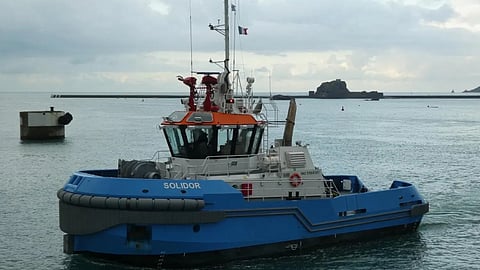VESSEL REVIEW | Solidor & Cite D'Aleth – Harbour and firefighting tugs to operate out of France’s English Channel ports
French shipbuilder Piriou recently delivered two new tugs in a series to the Port of Saint-Malo in France's Brittany region. Both tugs were built in Piriou's Vietnam facilities and were transported to France via heavy-lift vessel.
The Bureau Veritas-classed Cite D'Aleth and Solidor were acquired as part of a €10.3 million (US$11.5 million) investment to replace some of the ageing vessels at the ports where they will operate. The tugs are designed for use in the English Channel, hence the installation of exhaust aftertreatment systems to comply with IMO Tier III NOx emissions regulations. They will be operated by EDEIS Ports de Saint-Malo and Cancale.
“EDEIS needed tugs adapted to its operations and the conditions in the harbours it managed,” Piriou told Baird Maritime. “Specifically, the owner required tugs that were manoeuvrable, powerful, versatile, and modern.”
Multi-role harbour support vessels
The new tugs each have a length of 22 metres (72 feet), a beam of 8.5 metres (28 feet), and a draught of 4.2 metres (14 feet), making them suitable for navigating through the Saint-Malo lock and in the outer harbour. The vessels are capable of push-pull towing operations and barge handling while secondary functions will include firefighting, marine construction support, and limited dredging.
“The tugs were specifically designed to answer manoeuvrability constraints in the lock and the outer harbour to assist ships as they approach,” added Piriou. “Thanks to their proven hulls, they can operate further out to see if required.”
Each tug is fitted with bow and stern winches, a towing hook, a stern A-frame, custom fenders, and a Toimil knuckle boom crane as standard equipment to perform a range of activities. The wheelhouse is ergonomically laid out for enhanced operating efficiency and visibility while the stern deck is spacious enough for accommodating various types of marine service equipment.
The propulsion system includes two Caterpillar 1,081kW (1,450hp) high-speed engines and two ASD thrusters with integrated hydraulic gearboxes. This configuration can deliver a maximum speed of 12 knots and a bollard pull of over 30 tonnes.
The hull of each tug is protected by an anti-fouling coating with a maximum lifetime of three years and all water intakes are protected by ultrasonic devices. A box cooler is also available to cover the needs of all onboard machinery.
For firefighting, each tug relies on two monitors connected to a pump with a discharge rate of 1,400 cubic metres (49,000 cubic feet) per hour.
Ample accommodation with enhanced comfort
The crew spaces on each vessel include two cabins with a total of four berths, a galley, a mess, a laundry area, and sanitary facilities. The interiors are laid out in compliance with ILO 2006 standards and even feature air conditioning and adequate sound insulation.
Piriou explained that, as with the construction of other vessels, work on the new EDEIS tugs entailed some compromise.
“The tugs needed to be of limited size due to harbour constraints,” the builder told Baird Maritime. “This therefore meant limited buoyancy and stability while ensuring precise bollard pull, adequate comfort, and ample space for operations on board. Our engineers were successful in this regard.”
The company learned new insights through the project, particularly the importance of collaboration and of basing the design process on trust and cooperation between all parties involved.


